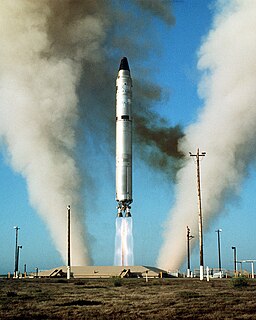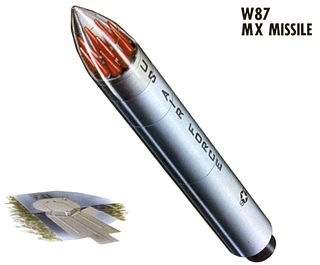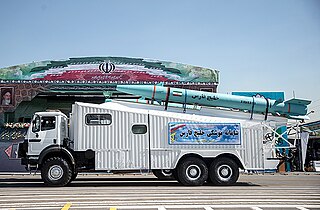 W
WA ballistic missile follows a ballistic trajectory to deliver one or more warheads on a predetermined target. These weapons are guided only during relatively brief periods—most of the flight is unpowered. Short-range ballistic missiles stay within the Earth's atmosphere, while intercontinental ballistic missiles (ICBMs) are launched on a sub-orbital trajectory.
 W
WAn intercontinental ballistic missile (ICBM) is a missile with a minimum range of 5,500 kilometres (3,400 mi) primarily designed for nuclear weapons delivery. Similarly, conventional, chemical, and biological weapons can also be delivered with varying effectiveness, but have never been deployed on ICBMs. Most modern designs support multiple independently targetable reentry vehicles (MIRVs), allowing a single missile to carry several warheads, each of which can strike a different target. Russia, United States, China, France, India, United Kingdom, and North Korea are the only countries that have operational ICBMs.
 W
WThe Ababil-100 or al-Fat'h or al-Fatah was an Iraqi single stage solid propelled Short-range ballistic missile whose development project started around August 1991 and was tested from 2000 to 2002. It was derived from the Ababil-50 MLRS.
 W
WThe Aggregat series was a set of ballistic missile designs developed in 1933–45 by a research program of Nazi Germany's Armed Forces (Wehrmacht). Its greatest success was the A4, more commonly known as the V-2.
 W
WAl-Samoud was a liquid-propellant rocket tactical ballistic missile developed by Iraq in the years between the Gulf War and the 2003 Invasion of Iraq. The Iraqi army also developed a solid-fuel rocket version known as Ababil-100.
 W
WThe Ghadr-110 is a medium-range ballistic missile designed and developed by Iran. The missile has a range of 1,800 km to 2,000 km. The Iranian Armed Forces first displayed the missile to the public at an annual military parade to mark the Iran–Iraq War.
 W
WThe Ghaznavi, is a Hypersonic surface to surface short range ballistic missile designed and developed by the National Development Complex, with the first version in service with the Pakistan Army's strategic command since 2004. With an optimal range of 290 km, it is named after the 11th century Muslim Turkic conqueror Mahmud of Ghazni. The word Hatf means deadly or vengeance in Arabic. It entered service with the Pakistan Army in 2012 after a successful launch conducted by ASFC on May 10, 2012.
 W
WThe Khorramshahr, named after the city of Khorramshahr in Iran, is a medium-range ballistic missile that was tested by Iran in January 2017. Its range is between 1,000–2000 km with a 1,800 kg warhead and is 13 m in length.
 W
WA medium-range ballistic missile (MRBM) is a type of ballistic missile with medium range, this last classification depending on the standards of certain organizations. Within the U.S. Department of Defense, a medium-range missile is defined by having a maximum range of between 1,000 and 3,000 kilometres. In modern terminology, MRBMs are part of the wider grouping of theatre ballistic missiles, which includes any ballistic missile with a range of less than 3,500 kilometres (2,200 mi).
 W
WA multiple independently targetable reentry vehicle (MIRV) is an exoatmospheric ballistic missile payload containing several warheads, each capable of being aimed to hit a different target. The concept is almost invariably associated with intercontinental ballistic missiles carrying thermonuclear warheads, even if not strictly being limited to them. By contrast, a unitary warhead is a single warhead on a single missile. An intermediate case is the multiple reentry vehicle (MRV) missile which carries several warheads which are dispersed but not individually aimed. Only China, Russia, United Kingdom, United States and France are currently confirmed to possess functional MIRV missile systems. Israel is suspected to possess or be in the process of developing MIRVs.
 W
WThe RTV-A-2 Hiroc was a product of the United States' first effort to develop an intercontinental ballistic missile (ICBM). The project was named MX-774. The project was canceled in 1947, but leftover funds were used to build and launch three of the planned 10 research vehicles designated RTV-A-2. The design included several innovations; the gimbaled thrust chambers provided guidance control, the internal gas pressure was used to support the airframe and the nose cap was separable. All of these concepts were later used on the Atlas missile and the first two on the Viking (rocket). Also developed as part of MX-774 was the Azusa guidance system which was not used on the Hiroc missile but did contribute to the Atlas missile as well as many other early guided missiles launched from Cape Canveral.
 W
WThe Hatf IX or Nasr, is a solid fueled tactical ballistic missile system developed by National Development Complex (NDC) of Pakistan.
 W
WKhalij Fars is an Iranian single-stage solid-propellant, supersonic anti-ship quasi ballistic missile with a range of 300 km based on the Fateh-110 missile. It is equipped with a 650 kg explosive warhead and an interception evading guidance system.
 W
WFrom the 1960s to the 1990s, South Africa pursued research into weapons of mass destruction, including nuclear, biological, and chemical weapons under the Apartheid regime. Six nuclear weapons were assembled. South African strategy was, if political and military instability in Southern Africa became unmanageable, to conduct a nuclear weapon test in a location such as the Kalahari desert, where an underground testing site had been prepared, to demonstrate its capability and resolve—and thereby the peril of intensified conflict in the region—and then invite a larger power such as the United States to intervene.
 W
WThe Commission to Assess the Ballistic Missile Threat to the United States, commonly called the Rumsfeld Commission, was an independent commission formed by the US Congress to evaluate the ballistic missile threat posed to the United States.
 W
WThe Shahab-2 is the successor to the Iranian Shahab-1 missile. It is based on the North Korean Hwasong-6.
 W
WThe Shahab-3 is a quad-exhaust liquid-propelled medium-range ballistic missile (MRBM) developed by Iran and based on the North Korean Nodong-1. The Shahab-3 has a range of 1,000 kilometres (620 mi); a MRBM variant can now reach 2,000 kilometres (1,200 mi). It was tested from 1998 to 2003 and added to the military arsenal on 7 July 2003, with an official unveiling by Ayatollah Khamenei on July 20. With an accuracy of 140 m CEP, the Shahab-3 missile is primarily effective against large, soft targets. Given the Shahab-3’s payload capacity, it would likely be capable of delivering nuclear warheads. According to the IAEA, Iran in the early 2000s may have explored various fuzing, arming and firing systems to make the Shahab-3 more capable of reliably delivering a nuclear warhead.